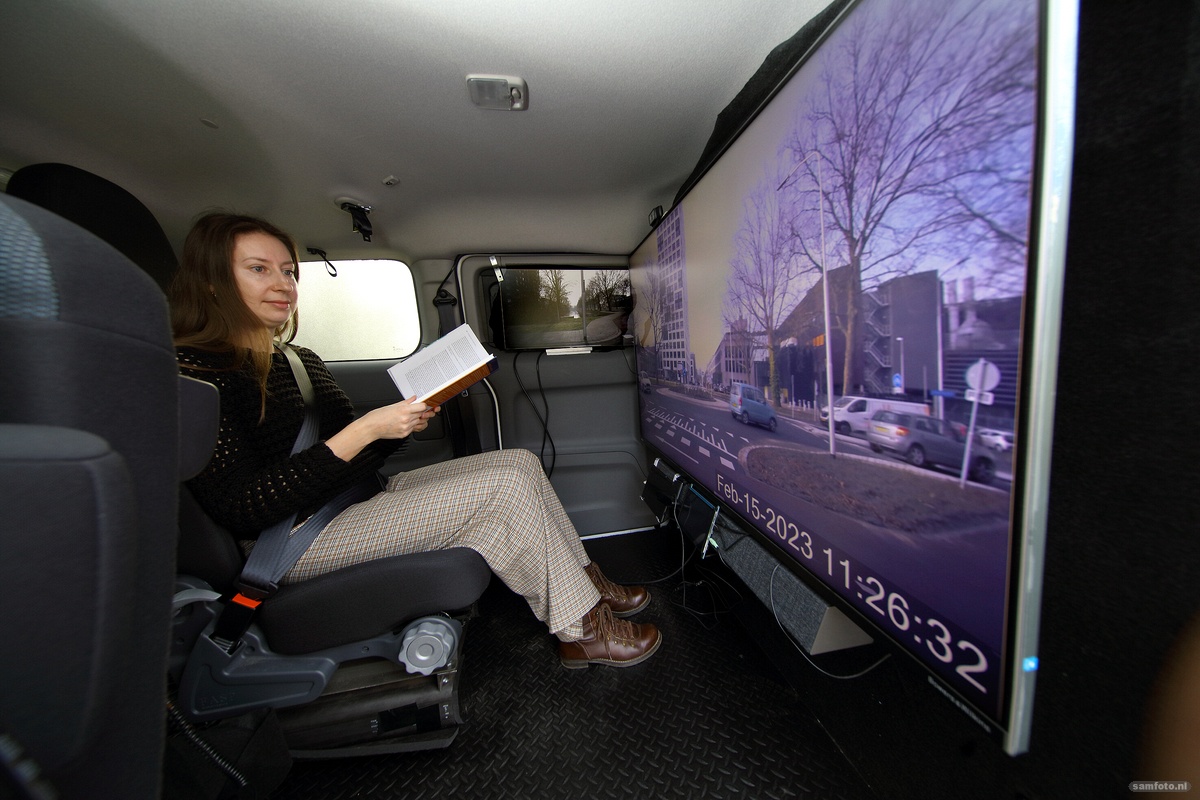How comfortable is a trip in a completely self-driving car? TU Delft researchers use a van and a driver to test this. One hundred people in Delft joined in.
Researcher Maryna Öztürker makes a trip in the experiments' self driving car. (Photo: Sam Rentmeester)
From the outside, the white electric van does not look that special. But when the sliding door of the load space opens, everything changes. Screens around the vehicle’s seats show what is happening outside. It is as though you are sitting in the driver’s seat, but with one major difference – you do not drive the vehicle yourself.
“We want to know what it feels like to sit in a self-driving car,” says doctoral candidate Maryna Öztürker of the TU Delft hEAT Lab. The Lab specialises in research on electric and automated transport. “Do passengers feel tense while travelling? Can you work comfortably while you are being driven around?” asks Öztürker. In other words, how quickly can people get used to transport in self-driving cars?
Many different road types
To answer these questions, about 100 people from Delft could sign up to ride in the test vehicle in November and December. It turned out to be popular. “We thought there was a problem with the website because within no time people were unable to sign up anymore,” says Sascha Hoogendoorn-Lanser, Director of the TU Delft initiated Mobility Innovation Centre Delft (MICD) that is leading the research. “But it turned out that the number of registrations had already reached full capacity within just two hours.”
The participants had to fill in a questionnaire beforehand. They then did two test drives of about 20 minutes each. They started at Café Labs on campus, then went on the Kruithuisweg along the De Hoven Passage shopping centre and onto the Zuidwal to return to campus. The route consisted of a main road outside town, a busy road along a shopping centre, and stretches of roads with traffic lights, says Öztürker. “We wanted to drive on as many different types of roads as we could.”
Carry out tasks
On the way, the participants had to carry out tasks. On the first ride it was a work-related activity on a laptop and on the second one something relaxing like scrolling on their telephones or reading a book. A camera with facial recognition filmed them while a smart watch measured their heartbeat. “We used a combination of the outside images and the movement of the vehicle to determine what was happening. For example someone may hear children’s voices outside and wants to know what is going on,” says Hoogendoorn-Lanser.
What the participants did not know was that the van was actually being driven by a driver. A completely self-driving vehicle is not permitted in normal traffic.
Realistic
The researchers made the experience as realistic as they could. To approximate the feeling of taking a trip in a self-driving car as closely as possible, the driver kept even more distance from other vehicles and braked more carefully than someone would normally do. Hoogendoorn-Lanser explains that for legal reasons this is what self-driving cars do.
The trick worked: the feedback afterwards showed that three quarters of the participants thought that the vehicle really was self-driving. Most of them enjoyed the trip. They answered questions about safety, time saving and comfort more positively after the trips than before. So what the participants did – work or relaxation – during the trips made little difference.
A driving simulator is less realistic than this self-driving car, says Hoogendoorn-Lanser. “You may be able to see the surroundings in a driving simulator, but you have to sit still in one place. In a real vehicle you feel everything – the turns, acceleration, braking. This is what gives added value to this experiment.”
Follow-up research
There is still one more reason to take to the road. The information about the comfort of the ride is also relevant for the MICD’s partners like the Municipality of Delft as well as the municipalities of Amsterdam and Utrecht she says. “Municipalities want to know if they should adapt their roads to self-driving.”
Follow-up research is also on the cards and will include monitoring the behaviour of the participants more closely. The researchers will see if there are differences in how self-driving is experienced by people who do not drive themselves, men and women, and older and younger people. Improving the comfort of self-driving cars will also be looked at.
These tests will not be in Delft, but Rotterdam and The Hague, says Hoogendoorn-Lanser. “Here in Delft we run the risk that people already know the experiment. Apart from that, Rotterdam and The Hague have more complicated traffic situations. This creates new opportunities.”
Do you have a question or comment about this article?
K.S.vanderWal@tudelft.nl


Comments are closed.